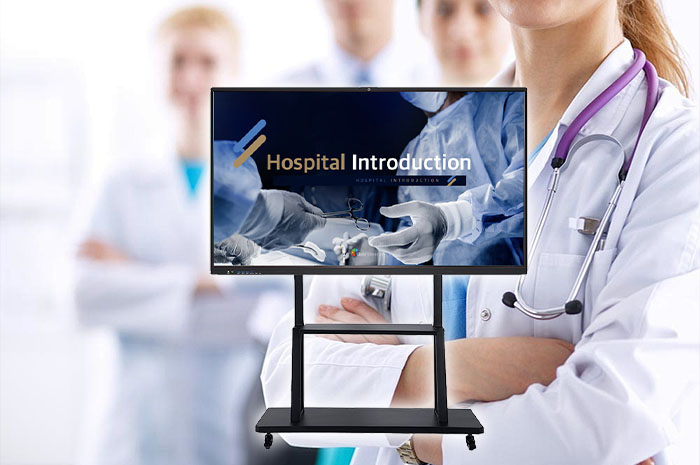
From the perspective of hospital managers, the application of Qtenboard IFPD in modern hospitals can not only improve medical quality, but also
significantly optimize operational efficiency.
First: Improve medical quality
A: Improve the efficiency of medical communication
Through the Qtenboard IFPD, patient information, test reports, medication records, etc. are displayed in real time. Doctors and nurses can view
and modify data simultaneously during rounds to reduce information errors.
Realize the visualization of multidisciplinary collaboration (MDT) consultation, which facilitates doctors from multiple departments to discuss
cases and make diagnosis and treatment decisions on the same interface.
B: Promote patient participation and health education
Use Qtenboard IFPD in wards or waiting areas to display health knowledge, rehabilitation training guidance animations, etc. to improve patient
compliance and satisfaction.
During hospitalization, the diagnosis and treatment plan can be shown to patients or their families to enhance their understanding and
cooperation.
C: Optimize surgery and clinical pathway management
Deployment of interactive whiteboards in operating rooms can be used for surgery scheduling, preoperative precautions reminders, intraoperative
operation visualization, etc., to improve surgical preparation and collaboration efficiency.
Hospitals can deploy clinical pathway templates on whiteboards to standardize diagnosis and treatment processes and improve diagnosis
and treatment consistency.
Second: Optimize hospital operation efficiency
A: Intelligent scheduling and resource scheduling
Information such as medical staff scheduling, bed usage, and department appointments can be visualized and scheduled on whiteboards, updated
in real time, and reduce manual coordination costs.
Resource arrangements such as inpatient departments, operating rooms, and examination departments are clear at a glance, improving
utilization efficiency.
B: Data-driven decision support
Hospital managers can use whiteboards to display department operation data and key performance indicators (KPIs) such as average hospital
stay days and bed utilization rates to assist in accurate decision-making.
Data can be displayed synchronously in combination with hospital information systems (HIS) and electronic medical record systems (EMR) to
dynamically track performance changes.
C: Improve training and meeting efficiency
In hospital internal training, morning meetings, case sharing and other meetings, Qtenboard IFPD are used for graphic presentations and remote
video connections to improve interactivity and efficiency.
Automatic saving of meeting records is supported to facilitate knowledge retention and review.
Summary: Why should hospital managers pay attention to Qtenboard IFPD?
Visualization: Make management clear at a glance and make decisions more scientific.
Standardization: Standardize medical processes and improve service consistency.
Intelligence: Integrate information systems to create a smart hospital ecosystem.
Humanization: Enhance doctor-patient communication and improve service experience.
